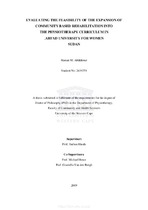| dc.description.abstract | Community Based Rehabilitation (CBR) is used internationally, to address the lack of access of People with Disabilities (PwD) to rehabilitation services. Physiotherapy is one of the rehabilitation services offered to PwDs at community level, through CBR. In Sudan, Ahfad University for Women (AUW) offers a Bachelor degree in Physiotherapy, which integrates a CBR module into the curriculum, since 2007.
The aim of this current study was to investigate the CBR components of the current physiotherapy curriculum at AUW, to determine whether they should, and could be expanded. The Mix method study design was employed, with a mixed research methodology, containing both qualitative and quantitative approaches for data collection. The components of CBR, present in the current physiotherapy curriculum at AUW were identified, using the constructive alignment framework, and content analysis for data analysis. The PWD’s needs of rehabilitation services in Sudan were established, using a questionnaire survey among users at various rehabilitation centres in Khartoum State. The CBR components that needed to be adapted in the physiotherapy curriculum at AUW were identified, using focus group discussions and in-depth interviews with AUW physiotherapy students and a CBR expert. Finally, the CBR components were revised and adapted, using a collaborative approach during workshops with AUW staff and clinicians.
It was concluded that, in order to address the rehabilitation needs of PwDs, the CBR module needed to include additional components, to align the course content, teaching and learning techniques, as well as assessment tasks, with the intended learning outcomes of physiotherapy students. The components in the CBR matrix, such as livelihood and empowerment, were deemed important to provide students with knowledge, skills and competence. Additionally, providing information about assistive devices was deemed vital in rehabilitation. A significant relationship (P<0.05) was observed between the provision of information on assistive devices, and the maintenance thereof, as well as the benefits to users, respectively. Ultimately, commencing CBR placements in the fourth year, as is currently the norm, was deemed too late; therefore, it was suggested that community visits in the first and second years of physiotherapy studies, be included in the CBR course curriculum. | en_US |

